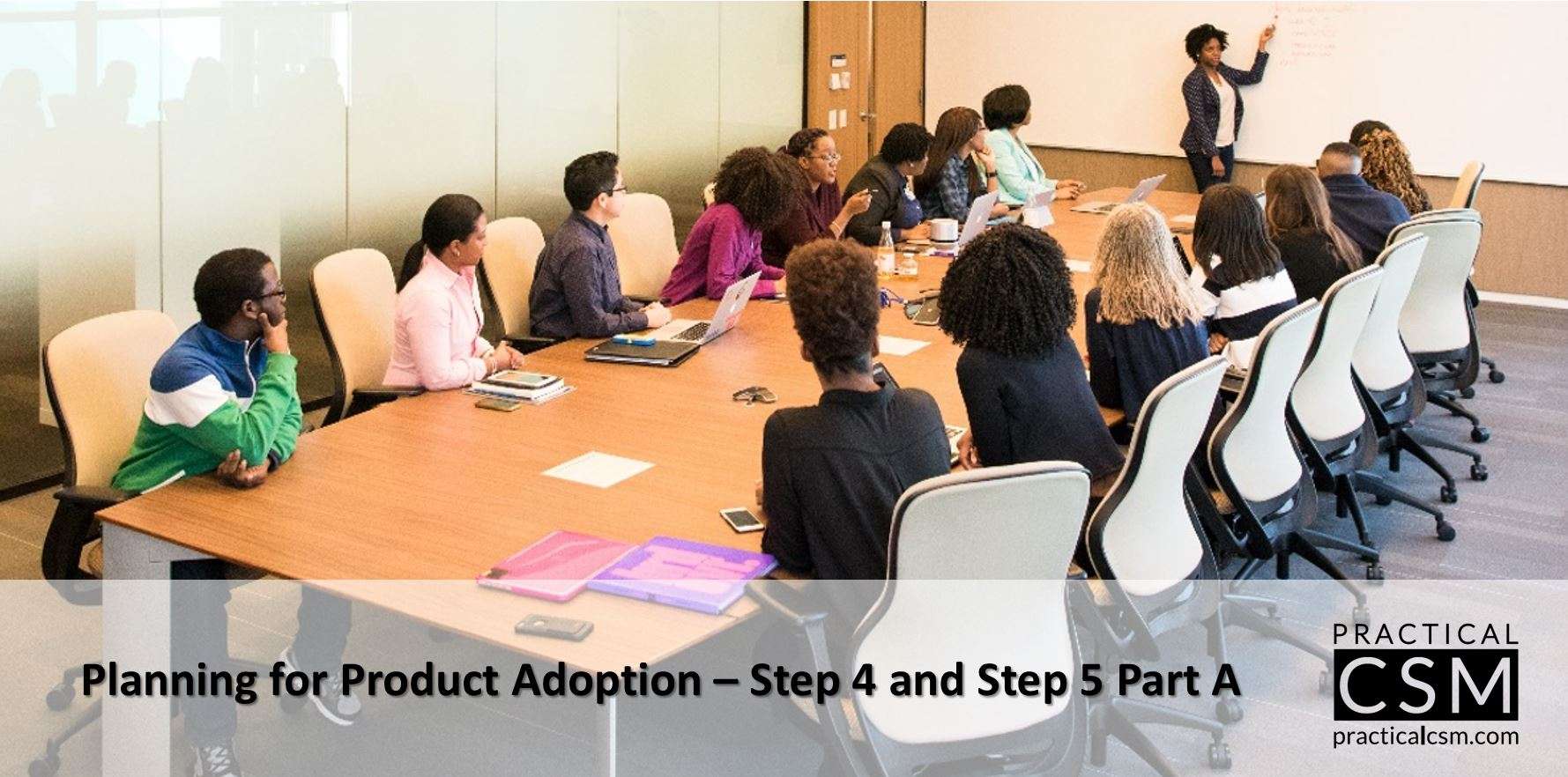Introduction
Depending upon the product (or service) in question, full product adoption can be a potentially quite complex and even onerous task to perform well. As with all complex tasks, the secret is to break it down into its constituent components and then to deal with each component one at a time (as much as possible at least). There are many ways in which product adoption could be divided up and broken down into separate parts. The steps I have divided up adoption planning into are shown below:
Step 1: Determine Adoption Requirements
Step 2: Identify Process Changes
Step 3: Create Impacted Groups (IGs)
Step 4: Document Practical Considerations
Step 5: Determine Communication, Training and Support Requirements
Step 6: Capture Adoption Barriers and Risks
Step 7: Create Outline Adoption Plan
Step 8: Create Adoption Proposal and Gain Acceptance
Step 9: Complete Full Adoption Plan and Publish Adoption Roadmap
In my previous articles I explained the first three steps in adoption planning, taken from Chapter 8 of my book Practical Customer Success Management. This week I’m focusing on Step 4: Document Practical Considerations and the first part of Step 5: Determine Communication, Training and Support Requirements. As I have mentioned in the previous articles in this series, being a chapter from the mid to later stages of the book, it does assume knowledge attained from previous chapters, and it also mentions downloadable tools that purchasers of the book have access to. But hopefully as a standalone series of articles it will provide a useful reference for CSMs who are looking for a way to break down the adoption planning process into a series of tasks and to learn how to perform each task efficiently and effectively. Also just to mention that of course adoption planning (and the use of the tools discussed herein) is also covered in detail in my Certified CSM Professional training program and within the upcoming Practical CSM Academy subscription site.
Step 4: Document Practical Considerations
Types of practical considerations
There are a number of different considerations relating to an adoption program that need to be dealt with up front during the adoption planning stage. These include (though are not limited to):
Table 1: Practical considerations for adoption
| Consideration | Description |
| Implementation Phases | Will the solution be rolled out all together or will it be rolled out in a series of phases? If the former, when will the implementation be completed? If the latter, when will each phase occur, what happens in each phase, and how will this impact the adoption plan? |
| User Availability | When are the users available, especially if they need to undergo any lengthy training? Are all users within an IG available together or will they need to be separated into multiple groups that undergo separate training in order to maintain productivity levels? |
| External Dependencies | Are there any activities that are outside of this initiative but which this initiative relies upon being completed prior to commencing the adoption? (For example do a group of new recruits need general induction training first before being exposed to the specific task-oriented training contained within the adoption plan?) |
| Internal Dependencies | Are there any activities that are outside of within this initiative and which must be completed prior to commencing the adoption? (For example is there some customization or integration work that must be completed before the adoption commences?) |
| Financing | Are there sufficient funds available for the completion of the adoption program and where will this funding come from? If cash is tight would it be better for cash flow reasons to divide the adoption roadmap into a series of phases where essential training is completed straight away and other training is left to be completed at a later stage when it becomes affordable? |
| Deadlines and Timeframes | Are there any hard deadlines by which or timeframes in which all or certain aspects of the adoption must be completed? For example a new piece of legislation, or the launch of a new product may each engender specific deadlines that must be met. |
| Milestones and KPIs | What does the customer require in terms of milestones en route to overall completion of the adoption program, and how will those milestones be measured? |
| Internal and External Standards | Must all or parts of the adoption program ensure conformity to internal and external standards, such as best practice guidelines and government or industry regulations? |
The CSM may be able to deal with these types of considerations in one-to-one conversations with the SPL (Senior Project Lead – my expression for the lead stakeholder whom the CSM works with on a day-to-day basis during the adoption process), or may wish to agree with the SPL to include discussions on one or more of these points in the conversations that will take place with other key stakeholders around outcome requirements and impacted users. However the information is gathered, the CSM should ensure it is fully documented ready for the adoption planning step.
Step 5: Determine Communication, Training and Support Requirements
Types of adoption activities
There are many types of activities that might be specified to for inclusion within an adoption program. The simplest way to consider what types of activities are required for each IG is to divide these activities into three types: communication activities, training activities and support activities These can be defined as follows:
- Communication Activities
Communication for disseminating information
This is usually the first type of activity to occur, and it is used early on to inform everyone about upcoming change in order to help prepare them for that change ahead of time. Communication is also used throughout the adoption process to keep people informed about what is currently happening (and what will happen next), who will be affected, why it is happening, when it is happening, where it will happen and how it is happening. Its primary role could therefore be described as information dissemination. This might include schedules of upcoming training events, explanations about how processes will change, contact information for people to use to ask questions or get help, and so on. It could also include communicating requirements for additional information – for example the CSM and SPL might need to send out survey questionnaires to learn more about certain impacted users’ training and/or support requirements (readers may wish to refer back to Section 3 of Chapter 7 for more discussion on research techniques, including surveys).
All sorts of communication formats can be used – emails, texts, intranet posts, letters, posters, leaflets, phone calls and face-to-face and virtual meetings can all be used as appropriate to share the necessary information with those that need to receive it and (where relevant) to give the opportunity for employees to ask questions and give their feedback.
Communication for addressing attitudinal issues
As well as its practical role to disseminate necessary information, communication is also used to impact the “A” in KSA – in other words where potential attitudinal problems with one or more IGs have been identified, communication is likely to be the main way of addressing these issues. “Problem” attitudes might include fear about coping, anger about being required to perform additional tasks, concerns about job security, and worries about not getting adequate support through the change.
Whilst not all fears can necessarily be completely allayed, and whilst not all stakeholders can be turned into raving fans who cannot wait for the change to occur, what the CSM and SPL need to ensure is that impacted users are at least acceptant. What this means in a practical sense is that impacted users accept that the change is going to happen and that they will need to play their part both in undergoing the change (for example by attending any required training) and in performing the new tasks post change (ie by following the new processes and not reverting to doing what they used to do prior to the change). Without this minimum requirement of acceptance from impacted users it will be very difficult to make the change occur successfully. Effective communication is therefore an essential component of any adoption plan, not just for information dissemination but also for addressing attitudinal issues.
Communication activities for addressing attitudinal issues will need to be carefully crafted to address the issues that have been identified in the IGs. A good way of getting employees on board is to ask a ‘C’ level or other senior leader to help out. A personal message from the CEO, COO or some other high level authority figure really helps to gain acceptance from employees. This needn’t become an onerous burden on the senior leader – it could for example be delivered as an address during an “all hands meeting”, or it could be a recorded message that is sent to all employees, or it could even be a short letter or email signed by the senior leader, or some combination of the above.
The role of the CSM in communications
CSMs should not generally get involved directly in communicating information to IGs. Instead their role is consultative and advisory, helping the SPL and other key stakeholders to develop a strong communications strategy that enables appropriate dissemination of information and which addresses any attitudinal issues as needed.
- Training Activities
Training for knowledge and skills
Training is aimed at filling the “K” (knowledge) and “S” (skills) component gaps of KSA (more information on KSA and the differences between knowledge and skills can be found in Chapter 7 Section 2). Some customers may use specific terminology to define differences between knowledge and skill training activities. For example a customer might refer only to learning new skills with the term training and might use another term such as education to refer to learning new knowledge. Whatever terminology the customer uses, it might be worth the CSM referring to knowledge and skills training in the same way to avoid misunderstandings and to ensure the customer’s stakeholders are comfortable with any learning-related conversations.
Meeting different knowledge and skill requirements
Different IGs will have different levels of these two needs, so each training activity should be carefully planned to meet a combination of one, other or both of these specific requirements.
Knowledge is often best provided by providing both concepts and examples and following these up with exercises. Concepts explain the knowledge to the trainee, whereas examples illustrate it. Concepts can sometimes be hard to understand in isolation, especially where the trainees do not have any real world experience that they can relate these concepts to. On the other hand, exercises usually cannot get the knowledge itself across on their own, but can often make the concepts much easier to understand because they contextualize those concepts by providing examples of real world situations that trainees can relate to. Exercises are used to try out the newly learned knowledge in a safe environment, such as working through a fictitious case study, or answering a series of questions.
Skills generally cannot be learned without repeatedly performing the activity itself, and generally speaking skills are both learned and improved through this repetitive performance of the activity, during which users are given feedback and advice on how to improve their performance. Skills training often takes the route of breaking down complex activities into a number of tasks and teaching the tasks one at a time. Then when the trainees are ready tasks can be gradually recombined, until finally the trainees can perform all tasks simultaneously. For example when teaching someone to swim it is common to hand the trainee a float to hold in their hands so that they can concentrate just on learning how to move their legs. Then they are asked to hold the float between their feet to keep their legs still whilst they learn the correct movement with their arms. Finally the float can be taken away and the trainee can use both arms and legs to swim without any flotation aid.
Task-based learning versus functionality-based learning
Rather than learning about all the different features and functions of the various tools that the trainees will need to use in the performance of their role, it may be better for the training to follow the specific tasks that need to be performed in each step of the new process that the trainees will be asked to perform.
This can sometimes reduce the amount of training needed to cover just the specific features and functions required by the tasks within the process. It can also make the training much easier for trainees to understand and to learn and then to repeat afterwards when back at work, since it contextualizes the training and links it directly to the actual steps of the process. This methodology works really well in situations where processes are highly defined and are repeated with little or no change each time they are performed.
On the other hand, where users will have a lot more autonomy over how they go about performing tasks and will potentially need to know how to select which tasks to perform and then perform those tasks in different orders and in different ways each time, it may be necessary to provide bother broader and deeper training on all relevant features and functions. These features and functions can then be used as a toolkit from which users can select each time a task must be performed. This latter type of training is more comprehensive in scope and therefore tends to be more expensive and time consuming to deliver since it is likely to cover more profound and in depth knowledge on every relevant feature and function rather than just those ones that a particular process uses.
Neither task-based nor functionality-based training is “better”, it is purely a question of the CSM pointing out the pros and cons of each and then helping the SPL to select whichever is appropriate to the needs of the IG in ensuring they are able to perform their new role.
Determining training needs and training effectiveness
How do you know exactly what training an individual or an IG needs? Also, once you have delivered the training, how do you know if the training was effective? These are two very reasonable questions to ask, and CSMs should ensure that the answers to both of these questions are addressed within the customer’s adoption plan.
Determining training needs during the planning phase and/or during training delivery
Training needs can be assessed up front to predetermine the specific training requirements for each IG or even for each individual worker within each IG and prior to performing the adoption planning process. This can be done by interviewing or surveying each worker, or by interviewing and/or surveying relevant managers (including team leaders and process owners as necessary) and recording this information as additional information to consider during adoption planning. This is potentially the best way of doing things if it is possible, because it will tend to produce an adoption plan that is more specifically pointed towards fulfilling the known training needs of each impacted user. This can make the adoption plan both more productive in its results and more efficient in its utilization of key resources – including time and money of course.
The potential issue with performing up front training needs assessment is that it is yet another task that needs to be performed prior to implementing the training. This means that adoption implementation can be delayed – perhaps unnecessarily – and costs can be increased. It may be very difficult and/or expensive to perform this up front research. It may be a lot easier to build the training assessment into the adoption plan itself as an activity that takes place during the adoption implementation rather than beforehand. This might be done the same way (eg through interviews and surveys of workers and/or managers) or it might even be done as a just-in-time activity where users and/or their managers determine their training needs at or just before the time that training will be delivered. This works particularly well for self-service style training where users are given a range of training options as a menu from which they can select their own personalized training plan. The disadvantage to this route is that it relies upon users and their managers knowing (and being honest about) their training needs, which might not always be the case, especially where new tools and processes that the users and/or their managers are not yet aware of are being introduced to them.







